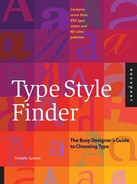
With so much recent exploration in typographic form, a great many type-
faces in use today can be considered progressive. Often, however, the results
of this experimentation invite the mind to make concrete associations that
aren’t strictly evolutionary. Typefaces that feel inherently progressive fall
into two major categories: those with conventional structure but whose
details clearly explore fundamental mutation in the form, and those whose
structure differs dramatically from convention. In the first category, serif/sans-
serif hybrids with unusually shaped counters, terminals, and junctures feel
innovative because they use the conventional form as a basis and actively
seek to alter it. In doing so, they exude a sense of purposeful investigation
away from the historical form while simultaneously paying homage to it.
The second category includes typefaces whose characters push the limits
of legibility, approaching a level of abstraction or symbolic representation,
suggesting a new way of representing language altogether. Typefaces whose
strokes or counters are replaced by abstract graphic elements, whose overall
shapes deviate from the letter archetypes, or whose characters are simplified
to the extreme—even missing information important for recognizability—all
are attempts to evolve typographic form beyond existing notions.
In the design world, work that challenges expectation and points to new
ways of thinking about visual communication is abundant. Sometimes
the challenge comes as a test of legibility, sometimes as an unexpected
juxtaposition of content or color. Typography that attempts to see the
future through undiscovered technology or inventive use of form asks
what can be rather than showing us what already is.
Conceptual Type Revision
top, and detail, bottom
LSD
Sonia Díaz, Gabriel Martínez
Based on Avenir Roman,
designed by Adrian Frutiger
Madrid Spain
Progressive
Concepts
138
(Provision) Type Style Finder
CL905.042 / 4237
5 TSF_CNCPT 2_126–157_.qxd 9/14/05 7:46 AM Page 138

5 TSF_CNCPT 2_126–157_.qxd 8/17/05 2:46 AM Page 139
P22 Bayer Fonetik
Stylized Sans Serif |
Medium Weight |
Unicase with Alternates |
P22 Type Foundry
www.p22.com
p22@p22.com
800.P22.5080
Ambex Thin
Sans Serif | Extended |
Light Weight |
T.26 Digital Type Foundry
www.t26.com
888.T26.FONT
Distilla Regular
Stylized Sans Serif |
Medium Weight |
T.26 Digital Type Foundry
www.t26.com
888.T26.FONT
Edit Roman
Graphic | Lighter
Medium Weight |
T.26 Digital Type Foundry
www.t26.com
888.T26.FONT
Quagmire Bold Extended
Sans Serif | Extended |
Bold Weight |
Device
www.devicefonts.co.uk
44 (0) 7979.602.272
ITC Binary
TM
Serif | Moderate Contrast |
Stylized Joints |
Slightly Condensed |
Linotype Library GmbH
www.linotype.com
info@linotype.com
+49 (0) 6172 484.418
Type Style Finder
139
D
D
t
D
t
D
t
D
t
D
(Provision) Type Style Finder
L805.130 / 4228

5 TSF_CNCPT 2_126–157_.qxd 8/17/05 2:43 AM Page 140
Concepts Progressive
Seebad
TM
Std Bold
Sans Serif | Bold Weight |
Rounded Joints | Condensed |
Linotype Library GmbH
www.linotype.com
info@linotype.com
+49 (0) 6172 484.418
Linotype Arab Stroke
TM
Regular
Sans Serif | Lighter Medium
Weight | Brush Influence |
Irregular Terminals |
Linotype Library GmbH
www.linotype.com
info@linotype.com
+49 (0) 6172 484.418
Egret Light
Stylized Sans Serif |
Condensed |
Medium Weight |
Device
www.devicefonts.co.uk
44 (0) 7979.602.272
F2F Metamorfosi
TM
Graphic | Medium Weight |
Substituted Characters |
Erratic Orientation |
Linotype Library GmbH
www.linotype.com
info@linotype.com
+49 (0) 6172 484.418
Linotype Scott
TM
Venus
Sans serif | Medium Weight |
Uniform Case Body Heights |
Linotype Library GmbH
www.linotype.com
info@linotype.com
+49 (0) 6172 484.418
Gravel Medium
Stylized Sans Serif | Condensed |
Medium Weight |
Device
www.devicefonts.co.uk
44 (0) 7979.602.272
140
t
D
D
D
t
D
t
D
t
D
(Provision) Type Style Finder
L805.130 / 4228

Sample Color Combinations
Type Style Finder
Progressive Color
Like progressive typefaces, progressive color is primarily a matter
of finding previously unimagined combinations—a difficult task.
Beginning with medium-value hues that are far apart on the color
wheel, or that appear to have no harmonic relationships, is a start:
violet and green, blue-violet and brown, olive and neutral gray.
Keeping the colors desaturated, as well as closer in value to each
other, forces their hues and temperatures to interact more intensely
and implies a studiousness that conveys purposeful exploration.
Color combinations that have historically been labeled a color
faux pas, such as red and pink, also transmit the idea of looking
past convention to find something new. Extremely bright colors
that refer to technology as part of the combination base, especially
when they interact with muted hues that are nearly complementary
or different in value, create a jarring effect that may seem futuristic
in outlook.
65 C
0 M
67 Y
0 K
>
76 C
55 M
0 Y
0 K
>
55 C
66 M
80 Y
0 K
>
0 C
0 M
100 Y
56 K
>
0 C
8 M
0 Y
50 K
>
100 C
15 M
15 Y
18 K
>
0 C
84 M
40 Y
0 K
>
0 C
100 M
100 Y
0 K
>
53 C
0 M
100 Y
0 K
>
60 C
63 M
0 Y
0 K
>
(Provision) Type Style Finder
CL905.042 / 4237
5 TSF_CNCPT 2_126–157_.qxd 9/16/05 10:03 PM Page 141
..................Content has been hidden....................
You can't read the all page of ebook, please click here login for view all page.
